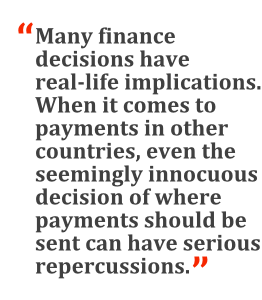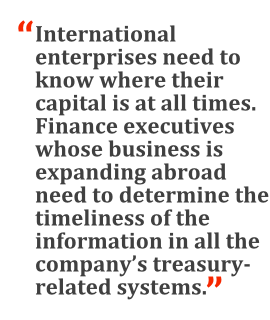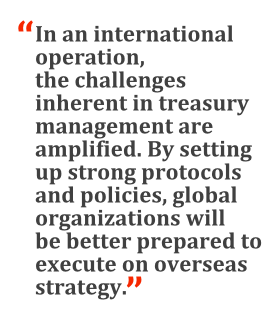 The amount of time thatU.S.-based finance executives devote to international affairscontinues to increase. According to the Bank of AmericaMerrill Lynch 2015 CFO Outlook, 54 percent of companies havesome involvement in foreign markets and 75 percent are operating intwo or more regions. The top geographic destinations for newoperations are Latin America, Asia, and Europe, in nearly equalnumbers.
The amount of time thatU.S.-based finance executives devote to international affairscontinues to increase. According to the Bank of AmericaMerrill Lynch 2015 CFO Outlook, 54 percent of companies havesome involvement in foreign markets and 75 percent are operating intwo or more regions. The top geographic destinations for newoperations are Latin America, Asia, and Europe, in nearly equalnumbers.
However, despite the number of organizations moving overseas,establishing overseas operations is not, by and large, a simpleproposition. As companies expand abroad, finance executives findthemselves managing entirely new challenges and risks that comefrom exposure to new markets, while they must continue tosuccessfully execute their business strategy. To mitigate some ofthese challenges, finance executives need new strategies fortreasury management, strategies that encompass major operationalrisks from exchange rate volatility to payment preferences ofcustomers.
|Even though every company's situation is different, bestpractices in building a truly global treasury organization includethe following:
||
Evaluate the policy directives for each market. As a first step, treasurers must undertake athorough review of the challenges involved in running a treasuryfunction in each market. The review should evaluate, in detail, thesituation on the ground for foreign exchange (FX) risk, liquiditymanagement, and intracompany activity.
|It should come as no surprise that foreign exchange risk is akey issue for finance executives in globally expanding businesses.Globalization usually requires a company to spend more money inforeign currencies for activities such as hiring staff members,setting up joint-operating agreements with partners, and buildingnew facilities. As a result, executives should consider thefollowing local regulations before deciding on any treasurypolicies:
- Is the exchange rate in the market fixed, floating, orpegged?
- What capital controls are in place?
- Are there any specific administrative requirements aroundcurrency conversion, such as supporting documentation?
- And, from a business perspective, are there business advantagesto billing in the local currency rather than dollars?
 Regulationsmay also complicate liquidity, or the ability of an organization topay its debts, in certain markets. For instance, somecurrencies—like the Chinese renminbi—are not fully convertible. Othercountries, such as Brazil, limit the movement of funds in and outof the country. It's also worth noting that Brazil has athree-tiered tax system, with federal, state, and municipal taxesas well as a financial transaction tax that affects transactionssuch as FX, loans, and investments. This complex tax system canimpact a foreign company's ability to repatriate any profits earnedin Brazil.
Regulationsmay also complicate liquidity, or the ability of an organization topay its debts, in certain markets. For instance, somecurrencies—like the Chinese renminbi—are not fully convertible. Othercountries, such as Brazil, limit the movement of funds in and outof the country. It's also worth noting that Brazil has athree-tiered tax system, with federal, state, and municipal taxesas well as a financial transaction tax that affects transactionssuch as FX, loans, and investments. This complex tax system canimpact a foreign company's ability to repatriate any profits earnedin Brazil.
In order to develop comprehensive liquidity managementstructures, companies must understand all the rules that affect themovement of cash, including the ability to reinvest the money, withan emphasis on:
- Local and regional tax liabilities;
- Repatriation rules—some countries, for instance, require fundsto be repatriated as dividends, which can take significanttime;
- Investment product options—for example, money market funds arenot as well-established in Asia as in the U.S. and U.K., and LatinAmerican countries including Chile and Peru have placedrestrictions on money market funds.
Regulations around intracompany activity can also be difficultto navigate, in particular rules around intracompany loans. Thismay be an important consideration for companies that want to fund anew location or joint venture, depending on how the new operationis being funded. In general, China and India have very strict ruleson moving money within an organization, and companies launching anew project must dedicate adequate time to navigating theiroptions.
||
Consider customer and employee expectations. Many finance decisions have real-lifeimplications, and this is certainly true when reaching newcustomers and hiring new employees. When it comes to payments inother countries, even the seemingly innocuous decision of wherepayments should be sent can have serious repercussions. Will yourcustomers object to sending a check to the United States? If youencourage credit card payments, will enough of your customers havea credit card account?
| Whenit comes to moving into new markets, companies must talk tocustomers and consider how they want to pay their bills. Forexample, in Europe, checks are less popular than they are in theUnited States. In addition, Switzerland and Brazil use paymentinstruments that are unique to just those countries. As a result,U.S. companies must be sure to use the payment structures that aremost common to, and preferred by, their customers, vendors, andpartners.
Whenit comes to moving into new markets, companies must talk tocustomers and consider how they want to pay their bills. Forexample, in Europe, checks are less popular than they are in theUnited States. In addition, Switzerland and Brazil use paymentinstruments that are unique to just those countries. As a result,U.S. companies must be sure to use the payment structures that aremost common to, and preferred by, their customers, vendors, andpartners.
At the same time, companies doing business abroad must considerthe cost of different payment methods. U.S. businesses may findthat they are paying up to $20 per cross-border wire payment, whilethey could reduce costs by using local options. By considering theneeds and desires of customers first, and then adding the businessrationale, finance executives can ensure that the paymentsenvironment works for everyone.
|In the same way that companies need to think about their newcustomers, they must also think about their new employees in eachmarket. One of the first decisions that must be made is how tomanage local cash payments. Even though “petty cash” accounts arenot popular in the U.S. anymore, many foreign offices expect them,and in some countries (such as China) they are required forregulatory reasons. But these types of accounts make it harder fora company to maintain full control over its cash.
|As a result, companies looking to expand overseas must be sureto consider a centralized, versus decentralized, system formanaging corporate bank accounts, payments and receivables, andcash around the world. In general, the best practice is to keepmost of the control at headquarters, while delegating someprocesses to local offices in a deliberate and strategic way. Localsubsidiaries may be given some independence to make decisions andmanage jobs, but the global treasurer should indicate, at thestart, the primary technology tools that all global treasury teamsare expected to use. These should include a dedicated workstationor banking system that gives corporate treasury visibility over allaccounts.
|By providing this oversight, the global treasurer can work moreeffectively with local controllers on issues such as repatriatingcash throughout the enterprise, which requires the input of peopleacross the network. Open communication between local controllersand headquarters is essential in building long-lastingrelationships.
||
Evaluate future needs. Ingeneral, setting up strong, rigorous policies at the beginning willenable a company to adapt to any situation. But when it comes totreasury, some decisions last longer than others. Consider thechoice of the banking model: Companies may opt to use regionalbanks, a single global bank, or a hybrid solution. For instance, acompany with a large and complicated foreign footprint may decidethat the ability of an international bank to manage foreignexchange rates makes it the logical choice of banking partner. Butat the same time, global banks may not be able to offer certainpayments products at the local level. Companies need to understandhow they will manage these structures. Changing the corporatebanking model once global operations are functioning can be verycomplicated, so companies should consider their future needs beforesettling on an option.
|Another consideration is whether outsourcing some treasuryfunctions would provide the company with more flexibility andexpertise than managing processes internally. The areas in whichoutsourcing often seems like a good choice include back-officeaccounting, local FX management, and payment processing.Back-office accounting, in particular, is often provided by thirdparties, so many companies have experience working with vendors inthat area. When it comes to currency management and paymentprocessing, a third-party vendor that has a deep understanding ofthe local market may be the right choice because it may haveenhanced experience with the myriad local rules and regulationsaround those activities.
||Reconsider the company's entire treasury technologyinfrastructure. International enterprises needto know where their capital is at all times, in order to maximizeinvestment and debt opportunities. Thus, finance executives whosebusiness is expanding abroad need to determine the timeliness ofthe information in all the company's treasury-related systems, andwhether each local system is compatible with the corporate treasurytechnology platform.
|Note that when making decisions related to IT requirements, itis best to take a five-year view, rather than a short-term view ofsix or 12 months. To that end, global organizations should be waryof systems with a local focus, as well as home-grown systems.
|New technologies can streamline and simplify cross-bordertreasury management. As a first step in determining whether theyneed a new treasury management system, finance executives shouldask the following questions:
 How“global” is the company's current banking platform? Does it allowfor input from other countries, and not just the one in which thetransaction originated?
How“global” is the company's current banking platform? Does it allowfor input from other countries, and not just the one in which thetransaction originated?- Can the centralized corporate treasury function remotely accessthe accounts receivable, accounts payable, and treasury managementsystems of the company's subsidiaries abroad?
- How easily can treasury add new entities, accounts, and reportsin each of these technology platforms?
- How accurate are the cash position reporting and cashforecasting for each geographic region? Are finance executives ableto easily review the most pertinent information, such as viacorporate reports or dashboards?
Modern treasury technology platforms usually help companiesestablish a disciplined approach for reporting between headquartersand subsidiaries, which can make the process as automated aspossible—and can help identify risks in the system.
|As an example, Bank of America Merrill Lynch worked with alarge, private U.S.-based university that purchased a campus inItaly and increased its program in London. In addition to ensuringthat the funds for both projects were available and secure, theuniversity's senior finance leaders wanted to track expenditures inreal time and offer employees convenience in making routinepurchases. Bank of America Merrill Lynch was able to providepurchase cards, equipped with chip and pin technology for greatersecurity, allowing the enterprise to monitor the cards viaterminals in the United States. This is just one example of howtechnologies can provide convenience and security.
||
Going Forward
|In an international operation, the challenges inherent intreasury management are amplified because of distance and culturaldifferences. While it is impossible to develop one strategy forconsistent operations everywhere, it is possible to develop oneframework for continuity, to allow the company and the treasuryfunction to grow organically, in an organized way.
|As companies continue to expand into new markets, a deepunderstanding of treasury needs is crucial. By setting up strongprotocols and policies between headquarters and other offices,along with using new technologies and treasury platforms, globalorganizations will be better prepared to execute on their overseasstrategy.
|—————————————-
| Lesley White is the head of Global CommercialBanking International for Bank of America Merrill Lynch, where sheprovides a single point of management across the full spectrum ofsolutions that the bank offers subsidiaries of its U.S. CommercialBanking clients. In addition, she helps coordinate the teams intreasury solutions, credit products, and client coverage to bestserve the needs of the bank's middle-market clientsglobally.
Lesley White is the head of Global CommercialBanking International for Bank of America Merrill Lynch, where sheprovides a single point of management across the full spectrum ofsolutions that the bank offers subsidiaries of its U.S. CommercialBanking clients. In addition, she helps coordinate the teams intreasury solutions, credit products, and client coverage to bestserve the needs of the bank's middle-market clientsglobally.
Complete your profile to continue reading and get FREE access to Treasury & Risk, part of your ALM digital membership.
Your access to unlimited Treasury & Risk content isn’t changing.
Once you are an ALM digital member, you’ll receive:
- Critical Treasury & Risk information including in-depth analysis of treasury and finance best practices, case studies with corporate innovators, informative newsletters, educational webcasts and videos, and resources from industry leaders.
- Exclusive discounts on ALM and Treasury & Risk events.
- Access to other award-winning ALM websites including PropertyCasualty360.com and Law.com.
*May exclude premium content
Already have an account? Sign In
© 2024 ALM Global, LLC, All Rights Reserved. Request academic re-use from www.copyright.com. All other uses, submit a request to [email protected]. For more information visit Asset & Logo Licensing.







